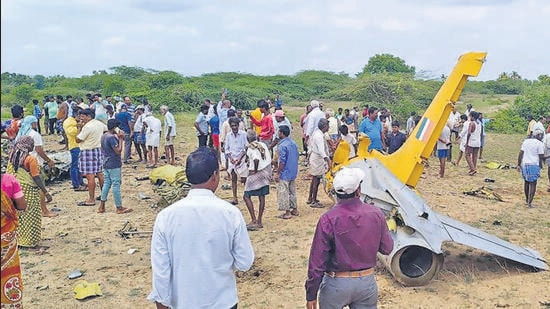An ageing Kiran trainer aircraft of the Indian Air Force (IAF), flown by one of India’s finest test pilots and with a woman flight test engineer aboard, crashed on the outskirts of Karnataka’s Chamarajanagar on Thursday, putting the spotlight on the decades-old plane and the pressing need to replace it with a modern aircraft, officials said.

Both aircrew ejected from the doomed trainer and were airlifted to Command Hospital Air Force, Bengaluru, for treatment. The air force did not release the names of the pilot or the engineer.
The aircraft and the aircrew are from the premier Bengaluru-based Aircraft and Systems Testing Establishment (ASTE) that conducts flight testing of aircraft and airborne systems, said one of the officials cited above, asking not to be named.
IAF has launched a probe into the accident.
Also Read: IAF Heritage Centre expansion: Air force to submit proposal to Chandigarh admn in 10 days
“A Kiran trainer aircraft of the IAF crashed near Chamarajanagar, Karnataka, today, while on a routine training sortie. Both aircrew ejected safely. A court of inquiry has been ordered to ascertain the cause of the accident,” the IAF said in a statement.
The test pilot is an air commodore while the flight test engineer is a squadron leader, said a second official cited above, who also asked not to be named. Only a handful of women officers in the IAF serve as flight test engineers – professionals who are responsible for evaluating aircraft and airborne systems. Squadron Leader Aashritha V Olety was the first woman officer to qualify for the role in May 2021, and till last year, there were only three women flight test engineers in the IAF.
The air force plans to retire the Kiran trainers by 2025, said a third official.
The much-delayed Sitara intermediate jet trainer (IJT), being developed by state-owned plane maker Hindustan Aeronautics Limited (HAL), was planned as a replacement for the IAF’s Kiran fleet to carry out stage-II training of fighter pilots. The IJT project is several years behind schedule and testing activity is still on.
Rookie IAF pilots go through a three-stage training involving the Swiss-origin Pilatus PC-7 MkII planes, Kiran trainers and finally the British-origin Hawk advanced jet trainers before they can fly supersonic fighter jets. The Kiran trainers were first inducted into the IAF in the 1960s.
The crash on Thursday took place at Bhogapura, about 10 km from Chamarajanagar town, local police said. Somashekar, a local resident and eyewitness, said: “The plane came from the Bengaluru side, turned around, then turned upside down and finally came crashing down. It crashed around half a kilometre from our gram panchayat building.”
A helicopter from HAL flew the senior test pilot and the flight test engineer to Command Hospital Air Force. “Both landed around half a kilometre from where the plane crashed. The pilot complained of back pain and the flight test engineer suffered minor injuries,” said a police officer.
The replacement of the Kiran aircraft is long overdue, said Air Marshal Anil Chopra (retd), director general, Centre for Air Power Studies. “It has played a critical training role for decades and served the IAF well. It is about time that it be replaced with a new intermediate jet trainer to meet important stage-II training requirements of the IAF,” Chopra added.
The IJT or the HJT-36 single-engine aircraft has completed a raft of crucial trials, but the testing process is still on, the officials said. The inordinate delay in the IJT programme, conceived almost 25 years ago, upset the IAF’s calculations and forced it to fly the Kiran trainers longer than it would have liked, the officials added. The project was sanctioned in July 1999 with a grant of ₹180 crore. The IJT was expected to get initial operational clearance by 2006.
In January 2022, HAL announced that the IJT had successfully demonstrated the capability to carry out six turn spins, a key requirement for trainers and the most crucial phase of flight testing. The capability to enter and recover from a spin is a necessity for a trainer aircraft to familiarise trainee pilots with departure from controlled flight and the actions required to recover from such situations.
To be sure, the IJT project is no longer backed by the IAF, and HAL had to dig into its internal funds to carry out critical trials after the project suffered a critical setback during spin testing in 2016 and brought the programme to a temporary halt.
The future of the IJT project looks uncertain and the IAF could lease trainer aircraft to meet its requirements after the Kirans retire, the officials said.
To be sure, at Aero India 2023, held at the Yelahanka airbase in Bengaluru in February, IAF chief Air Chief Marshal VR Chaudhari led the “gurukul” formation in the light combat aircraft Tejas. The HTT-40 basic trainer aircraft, the IJT and the Hawk-i aircraft were part of the four-aircraft formation.
Apart from intermediate jet trainers, the IAF also needs basic trainer aircraft to meet stage-I training requirements. In March, the defence ministry signed a ₹6,838-crore contract with HAL for 70 HTT-40 basic trainer aircraft. The new trainer aircraft, a longstanding need, will provide a boost to the ab initio training of air force pilots. Just like the Pilatus PC-7 MkII planes, these indigenous basic trainers could also be used for stage-II training if needed, the officials said.



